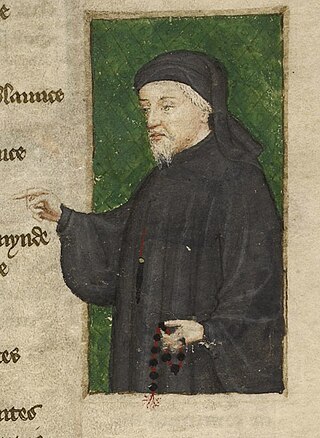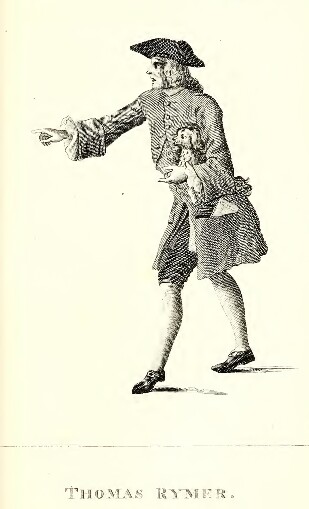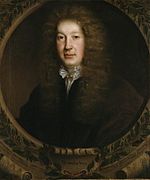In poetry, a couplet or distich is a pair of successive lines that rhyme and have the same metre. A couplet may be formal (closed) or run-on (open). In a formal (closed) couplet, each of the two lines is end-stopped, implying that there is a grammatical pause at the end of a line of verse. In a run-on (open) couplet, the meaning of the first line continues to the second.

The Canterbury Tales is a collection of twenty-four stories that runs to over 17,000 lines written in Middle English by Geoffrey Chaucer between 1387 and 1400. It is widely regarded as Chaucer's magnum opus. The tales are presented as part of a story-telling contest by a group of pilgrims as they travel together from London to Canterbury to visit the shrine of Saint Thomas Becket at Canterbury Cathedral. The prize for this contest is a free meal at the Tabard Inn at Southwark on their return.

Geoffrey Chaucer was an English poet, author, and civil servant best known for The Canterbury Tales. He has been called the "father of English literature", or, alternatively, the "father of English poetry". He was the first writer to be buried in what has since come to be called Poets' Corner, in Westminster Abbey. Chaucer also gained fame as a philosopher and astronomer, composing the scientific A Treatise on the Astrolabe for his 10-year-old son, Lewis. He maintained a career in the civil service as a bureaucrat, courtier, diplomat, and member of parliament.

Quintus Horatius Flaccus, commonly known in the English-speaking world as Horace, was the leading Roman lyric poet during the time of Augustus. The rhetorician Quintilian regarded his Odes as the only Latin lyrics worth reading: "He can be lofty sometimes, yet he is also full of charm and grace, versatile in his figures, and felicitously daring in his choice of words."
A heroic couplet is a traditional form for English poetry, commonly used in epic and narrative poetry, and consisting of a rhyming pair of lines in iambic pentameter. Use of the heroic couplet was pioneered by Geoffrey Chaucer in the Legend of Good Women and the Canterbury Tales, and generally considered to have been perfected by John Dryden and Alexander Pope in the Restoration Age and early 18th century respectively.

Publius Ovidius Naso, known in English as Ovid, was a Roman poet who lived during the reign of Augustus. He was a younger contemporary of Virgil and Horace, with whom he is often ranked as one of the three canonical poets of Latin literature. The Imperial scholar Quintilian considered him the last of the Latin love elegists. Although Ovid enjoyed enormous popularity during his lifetime, the emperor Augustus exiled him to Tomis, the capital of the newly-organised province of Moesia, on the Black Sea, where he remained for the last nine or ten years of his life. Ovid himself attributed his banishment to a "poem and a mistake", but his reluctance to disclose specifics has resulted in much speculation among scholars.

John Dryden was an English poet, literary critic, translator, and playwright who in 1668 was appointed England's first Poet Laureate.

The Metamorphoses is a Latin narrative poem from 8 CE by the Roman poet Ovid. It is considered his magnum opus. The poem chronicles the history of the world from its creation to the deification of Julius Caesar in a mythico-historical framework comprising over 250 myths, 15 books, and 11,995 lines.

John Lydgate of Bury was an English monk and poet, born in Lidgate, near Haverhill, Suffolk, England.

Thomas Rymer was an English poet, literary critic, antiquary and historiographer.

Troilus and Criseyde is an epic poem by Geoffrey Chaucer which re-tells in Middle English the tragic story of the lovers Troilus and Criseyde set against a backdrop of war during the siege of Troy. It was written in rime royale and probably completed during the mid-1380s. Many Chaucer scholars regard it as the poet's finest work. As a finished long poem, it is more self-contained than the better known but ultimately unfinished The Canterbury Tales. This poem is often considered the source of the phrase: "all good things must come to an end" (3.615).

Confessio Amantis is a 33,000-line Middle English poem by John Gower, which uses the confession made by an ageing lover to the chaplain of Venus as a frame story for a collection of shorter narrative poems. According to its prologue, it was composed at the request of Richard II. It stands with the works of Chaucer, Langland, and the Pearl poet as one of the great works of late 14th-century English literature. The Index of Middle English Verse shows that in the era before the printing press it was one of the most-often copied manuscripts along with Canterbury Tales and Piers Plowman.
Palamon and Arcite is part of Fables, Ancient and Modern written by John Dryden and published in 1700. Palamon and Arcite is a translation of The Knight's Tale from The Canterbury Tales by Geoffrey Chaucer. Although the plot line is identical, Dryden expanded the original text with poetic embellishments. The source of Chaucer's tale was Boccaccio's Teseida. Translations include those by Percival Ashley Chubb (1899) and Walter William Skeat (1904).
The following outline is provided as an overview of and introduction to poetry:
Decasyllabic quatrain is a poetic form in which each stanza consists of four lines of ten syllables each, usually with a rhyme scheme of AABB or ABAB. Examples of the decasyllabic quatrain in heroic couplets appear in some of the earliest texts in the English language, as Geoffrey Chaucer created the heroic couplet and used it in The Canterbury Tales. The alternating form came to prominence in late 16th-century English poetry and became fashionable in the 17th century when it appeared in heroic poems by William Davenant and John Dryden. In the 18th century famous poets such as Thomas Gray continued to use the form in works such as "Elegy Written in a Country Churchyard". Shakespearean Sonnets, comprising 3 quatrains of iambic pentameter followed by a final couplet, as well as later poems in blank verse have displayed the various uses of the decasyllabic quatrain throughout the history of English Poetry.

Contact between Geoffrey Chaucer and the Italian humanists Petrarch or Boccaccio has been proposed by scholars for centuries. More recent scholarship tends to discount these earlier speculations because of lack of evidence. As Leonard Koff remarks, the story of their meeting is "a 'tydying' worthy of Chaucer himself".
The Floure and the Leafe is an anonymous Middle English allegorical poem in 595 lines of rhyme royal, written around 1470. During the 17th, 18th, and most of the 19th century it was mistakenly believed to be the work of Geoffrey Chaucer, and was generally considered to be one of his finest poems. The name of the author is not known but the poem presents itself as the work of a woman, and some critics are inclined to take this at face value. The poet was certainly well-read, there being a number of echoes of earlier writers in the poem, including Geoffrey Chaucer, John Lydgate, John Gower, Andreas Capellanus, Guillaume de Lorris, Guillaume de Machaut, Jean Froissart, Eustache Deschamps, Christine de Pizan, and the authors of the "Lai du Trot" and the Kingis Quair.

Tartarium, also known as cloth of Tars, was a luxurious textile during the Middle Ages. It was characterized by its high cost and was typically crafted through the combination of various materials.












